Basic definition of Point series
The Point series of the Princeton offense primarily features a high post entry pass followed up by additional actions, ultimately to create scoring opportunities around the rim or near perimeter areas of the basketball court.
Common areas of the court occupied by players executing Point
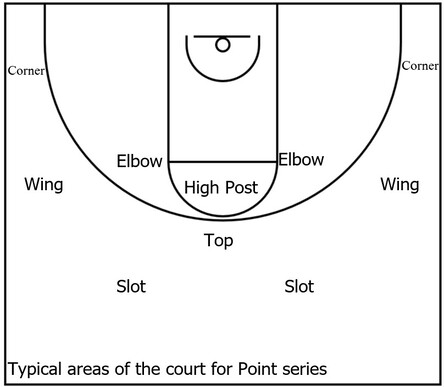
The common areas of the court that players will generally occupy while executing the Point series are the top, the slots, the wings, the high post, specifically, the elbows, as well as the corners.
The adjacent diagram above displays the common spots and it should also be noted that each of those areas are spaced apart at least 10-12 feet or more.
Therefore when any player fills one of these particular areas while other teammates occupy other vacant spaces, then that would be representative of good spacing, which is an important concept to understand and implement.
In essence, good spacing makes it more challenging for the defensive team to effectively guard against offensive actions within the Point series, which could lead to easier scoring possibilities.
The following subsections contain brief descriptions of the relevant court areas within the Point series.
Top
The top, sometimes referred to as top of the key or point, is the general area located behind the three-point line in the middle of the offensive team’s frontcourt.
In terms of the Point series, players will typically occupy the top after initiating the high post entry pass.
Slots
The slots, sometimes called the lane line extended areas, are the general areas that are adjacent to the top area as well as the areas between the top and the wings.
Players generally fill the slot areas during the initial phase of the Point series. However, at specific moments within the offense, players might fill the slot after cutting from other areas of the court such as the wing, corner or near the basket.
Wings
The wings consists of the court areas behind the three-point line that are adjacent to the nearest sideline, which is generally at or above the free throw line extended.
Players typically occupy the wing areas during the initial action of the Point series. However, a player may also fill one of the wings after certain offensive actions such as receiving a down screen that was set by a teammate.
Corners
The corners comprise the areas behind the three-point line that are in the general vicinity of a sideline and its adjoining baseline.
Within the Point series, players will typically occupy the corner areas to set up another action such as a basket cut to score points via a high percentage field goal attempt such as a layup or dunk.
High post + Elbows
The high post is the general area that covers the free throw line from one edge to the other as well as the adjacent area that is between the free throw line and the top of the three-point line.
Furthermore, the edges of the free throw line are typically known as the high post elbows or simply, the elbow areas of the court.
Within Point, a player commonly occupies the high post elbow area to receive the ball and then that is followed up with one or more scoring opportunities.
Initial setup for Point
The most typical initial setup for the Point series is the 2-2-1 alignment.
This is shown with an example diagram below.
Furthermore, in reference to the diagram within this section as well as other diagrams within subsequent sections, each offensive player is indicated by a number that generally represents one of the standard basketball positions.
Essentially, 1 is the point guard while 2 is the shooting guard.
3 is the small forward while 4 is the power forward.
Lastly, 5 plays the role of the center position.
Additionally, it should be mentioned that the Point series and by extension, the overall Princeton offense, can also be utilized by positionless teams in which all five players can interchange roles or at the very least, four players can switch roles while one player remains in the same role, mainly operating from the high post area of the court.
Nevertheless, for this section as well as later sections, players will usually remain in the traditional basketball roles unless stated otherwise.
2-2-1 alignment
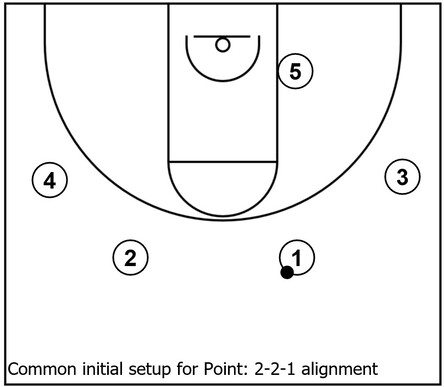
This is an example of the 2-2-1 alignment for the Point series.
Moreover, to give more clarity on the naming convention for the 2-2-1 alignment, the digits that are to the left or right of a dash (-) represents the number of offensive players located within a general region of the court.
What’s more, if a formation or alignment contains only one dash, then the number of players to the left of the dash would represent the front or top region while the number of players to the right of the dash would represent the back or bottom region.
In a similar fashion, if a formation or alignment contains two dashes, then the number of players to the leftmost of the dashes would represent the front or top region, the number of players in between the leftmost and rightmost dashes would represent the middle region, and the number of players to the rightmost of the dashes would represent the back or bottom region.
This could also apply to other formations or alignments as well.
So, with all that said, for the case of the 2-2-1 alignment, this means that there are two offensive players located at the front region (i.e. the slot areas), two offensive players located in the middle region (i.e. the wing areas), and one offensive player located in the back region (i.e. the low post area).
To be even more specific for this case, there are two guards (1 and 2) in the slots, two forwards (3 and 4) on the wings, and one traditional low post player (5) who begins near the low post area on the strong side of the court.
In addition to that, this particular set could be generally referred to as a 2-guard front as well because there are specifically two guards located in the front region of the alignment/formation.
Examples of initial actions to begin Point
This section contains various examples of initial actions that could be utilized to begin the Point series. These generally include a slot to slot pass, a slot to top dribble, or a slot to wing pass.
Also, it should be noted that while these examples showcase different iterations of initiating Point, it is possible that there are other ways to start the offense as well.
Example 1-1: Slot to slot pass and cut through
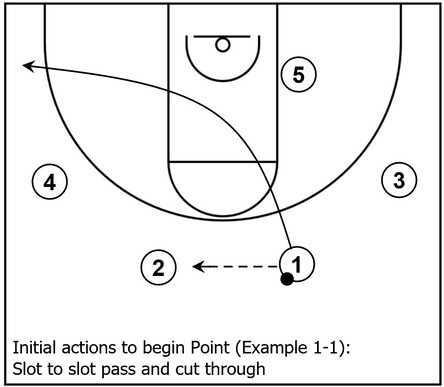
This is an example of the initial action of the Point series that demonstrates a slot to slot pass followed by the passing player cutting through to the corner, which is also known as a through cut.
Essentially, the play initiator, who is 1, has possession of the basketball and throws it to the recipient in the opposite left slot, who is 2.
From there, 1 simply cuts through to the left side corner and afterwards, the action continues in the following diagram.
Example 1-2: Top dribble, elbow lift, and high post pass
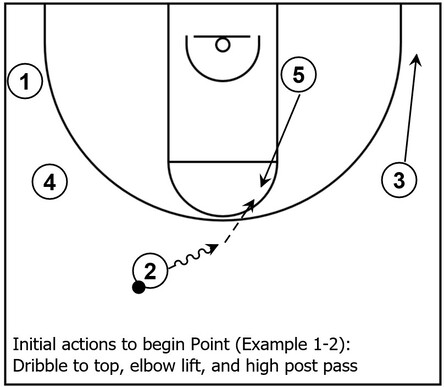
Next, 2 dribbles toward the top and as that occurs, 5 lifts up from the right side low post to the right side elbow area to receive the ball.
Additionally, 3 spaces out to the empty right side corner.
From this point, the team is ready to execute various plays and scoring options within the Point series.
Example 2: Top dribble, cut through, and flash
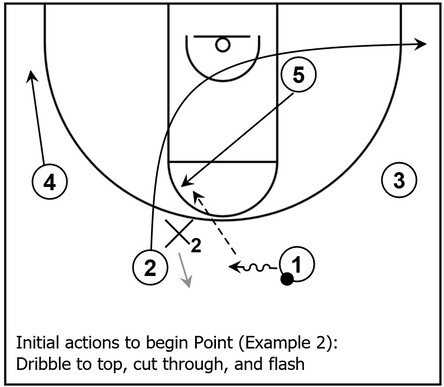
In some cases, the slot to slot pass may not feasible. For example, a defender who is guarding the player in the opposite slot may execute denial action by placing a hand or their entire body in the passing lane.
This could be an attempt by the opposing defender to stagnate the offense.
However, if that happens, it is possible to execute a different variation of the initial actions, which are shown on the adjacent diagram above.
Essentially, on the diagram, a defender covering 2 known as X2 is placing their hand or body between the passing lane of 1 and 2, represented by the gray arrow.
Therefore, instead of passing to the opposite slot, 1 simply dribbles toward the top and uses the non-dribbling off hand to wave 2 through to the right side corner.
Furthermore, as that occurs, 5 executes a flash cut to the left side elbow area at the high post and receives the ball from 1.
In addition to that, 4 spaces out to fill the empty left side corner.
It is also important to note that 5 should time the cut appropriately as 1 begins to dribble the ball.
That is to say, 5 shouldn’t leave the low post area too early before the dribble action happens or even too late.
This is mainly necessary to prevent denial action by a defensive player who could be assigned to guard against 5.
Example 3-1: Slot to wing pass and cut through
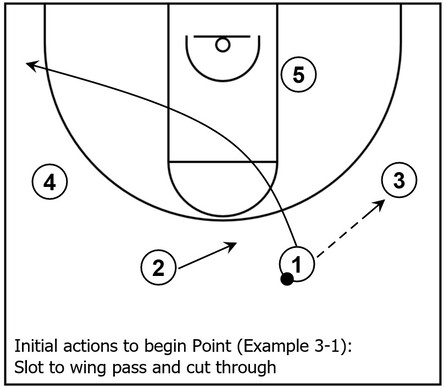
This is an example of yet another variation of initial action to begin the Point series.
This time, there is a slot to wing pass, also known as a wing entry.
A team may use this particular option to initially consider starting the Low post series of Princeton offense or simply as a type of false motion or delay action to occupy the defense.
This action could also be implemented during transition offense or fast break, which is demonstrated in another diagram below.
At any rate, 3 receives the ball from 1 who cuts through and away to the left side corner.
Moreover, 2 leaves the left slot area to occupy the top space.
Example 3-2: Wing to top and high post entry pass
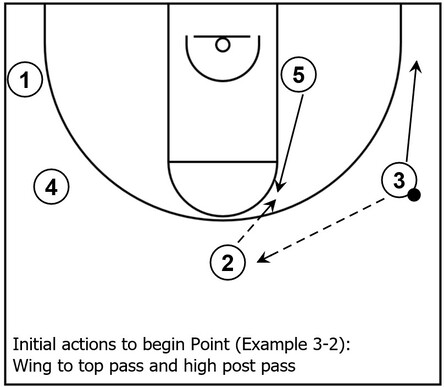
Next, 2 receives the ball from 3 and as that happens, 5 lifts up to the right side elbow area to gain possession of the ball from 2.
Also, 3 spaces out to the empty right side corner and from there, the team is ready to execute different plays and scoring options within the Point series.
Example 4: Transition/fast break into Point series
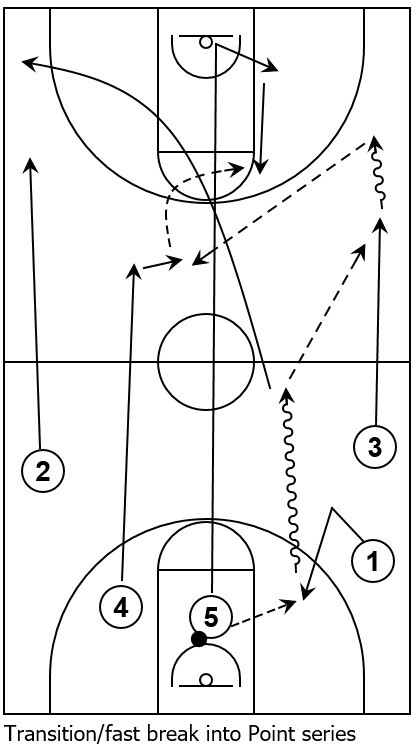
This is an example showcasing initial action of the Point series, particularly the wing entry option, derived from transition offense or general fast break action.
In terms of the diagram, let’s assume that the opposing team missed a shot, which allowed 5 to collect a defensive rebound near the basket in the offensive team’s backcourt.
Next, let’s say that 1 gets open with a V-cut and receives the ball from 5.
As that occurs, 2, 3, and 4 begin to sprint into the offensive team’s frontcourt while 1 dribbles toward the frontcourt as well.
2 eventually fills the left side wing while 4 initially settles in the left slot area.
Furthermore, 5 sprints as hard as possible directly to the front of the rim while 1 throws a pitch ahead pass with 3 as the recipient.
Immediately following that pass, 1 cuts through and away to the left side corner.
At the same time, 3 takes one or two dribbles toward the right side wing to give a quick look inside to 5 who moves out toward the right side low post area.
Moreover, after 1 cuts through and away, 4 slides to the top and receives the ball from 3, assuming 5 was not open to receive it in the low post area.
Afterwards, 5 lifts to the right side elbow area and receives the ball from 4.
From there, the team is ready to execute the different scoring options of the Point series.
Examples of basketball plays for Point
This section comprises examples of various basketball plays and scoring options within the Point series, which also feature sub-series or subsets known as Point Away, Point Under, and Point Over.
Essentially, after the high post entry pass occurs, the player who threw that pass will cut away from, cut under, or cut over the high post player to create one or more possibilities to score points near the basket or near perimeter areas of the court.
It should also be mentioned that for each of these diagrams, the initial action has already occurred, particularly the slot to top dribble action.
Therefore, 1 will generally be the player who will cut away, under, or over in most, if not all, cases.
Point Away
This subsection includes several basketball plays and scoring options within the Point Away subset.
Option 1: Screen away and rejection
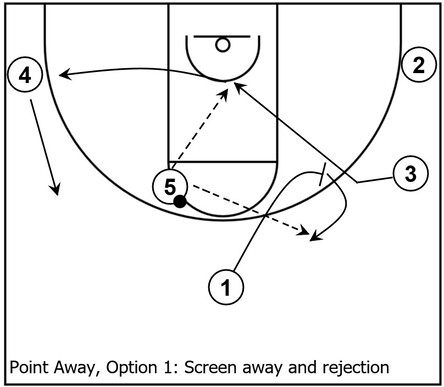
This is an example of the screen away action and screen rejection scoring option within the Point Away subset of the overall Point series.
To begin, 1 cuts away from the ball to set a screen for 3. However, 3 rejects that screen and cuts to the basket.
Following that, 3 receives the ball from 5 and scores at the rim.
Alternatively, if 3 is not open, then 3 can continue through to the left side corner while 4 lifts up to the left side wing.
Also, 1 can pop back to the right slot area and receive the ball from 5, which then sets up the next option.
In addition, as a side note, when an offensive player makes a high post or low post entry pass and then cuts away from the post to set or receive a screen, it is typically referred to as a split cut or post split action.
In other words, 1 is executing a split cut or performing post split action following the entry pass into the high post area.
Option 2: Spread pick and roll

This particular option demonstrates spread pick and roll action with two three-point shooters initially in the corners and one additional three-point shooter near the left side wing area.
In essence, 5 follows the previous pass to set an on-ball screen for 1 who uses the screen to dribble towards the basket.
At the same time, 5 rolls to the basket while 2 shakes up toward the right side wing.
Following that, 1 can take the mid-range jump shot or pass to one of the other teammates for scoring opportunities near the perimeter areas or near the basket, particularly in the case of 5.
Option 3: Backdoor cut

In some instances, after 3 rejects the screen, initially set by 1, and cuts through to the left side corner, 1 may not be able to easily receive the ball due to denial action by an adjacent defender.
If that is indeed the case, then a backdoor cut is a viable option, which is usually a good choice when the opportunity presents itself within the overall Princeton offense.
Essentially, on the adjacent diagram above, 1 is being denied by the defensive counterpart, X1.
So, when that happens, 5 could take a dribble towards 1, which is a signal for 1 to backdoor cut to the basket.
Afterwards, 1 could receive the ball from 5 and score at the rim by way of a swift layup.
Option 4: DHO

For this particular example, 1 cuts away from the ball to set a screen with 3 as the recipient.
However, instead of rejecting the screen, 3 can actually use it and curl cut towards the high post area.
Furthermore, as that happens, 5 could dribble towards 3 to execute a DHO or dribble handoff, represented by the double pipe symbol.
After receiving the ball via the DHO, 3 can turn and attack the rim while 5 rolls to the basket.
Following that, 3 can stop and pop for a mid-range shot, pass to 4, which could lead to a possible three-point shot, or pass inside to 5 for a close-range shot.
Alternatively, although it is not shown on the diagram, 3 could also reverse pivot and throw a pitch back pass with 1 as the recipient who popped back to the right slot area following the screen away action.
Point Under
This subsection consists of different basketball plays and scoring options within the Point Under subset.
Option 1: Basic handoff
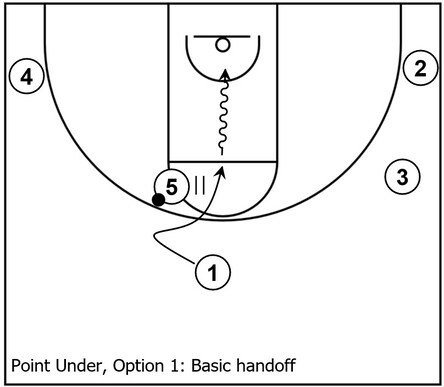
This is an example of very basic handoff action within the Point Under subset of the overall Point series.
Essentially, 1 simply cuts under 5, receives the ball via handoff, shown with the double pipe symbol, and dribbles to the basket to score via a close-range shot such as a layup, dunk, or floater.
Option 2: Pin down screen and slip
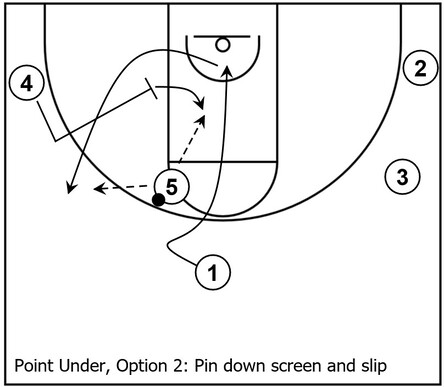
For this option, 1 cuts under 5 as before. However, this time, 1 does not receive the ball via handoff and continues cutting toward the basket.
At the same time as 1 does not receive the ball, 4 quickly fakes a cut toward the adjacent wing before cutting towards the left side low post area to set a pin down screen with 1 as the recipient.
After that, 1 cuts to the left side wing area and can receive the ball from 5, which could lead to an open three-point jump shot opportunity.
Alternatively, 4 can slip to the basket and receive the ball as opposed to 1, especially if defensive switching happens, which could also result in mismatches.
Option 3: Flex
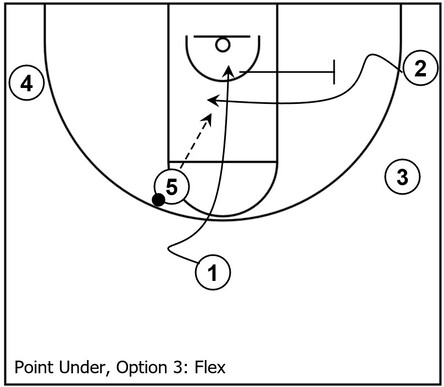
For this example, after 1 cuts under 5 and does not receive the ball, 1 cuts across the lane to an area between the right side low post and right side corner to set a flex screen.
Afterwards, 2 cuts to the basket via a flex screen set by 1 who replaces at the right side corner as well.
From there, 2 receives the ball from 5 and scores via a layup at the rim.
Point Over
This subsection contains multiple basketball plays and scoring options within the Point Over subset of Princeton offense.
Option 1: Curl cut
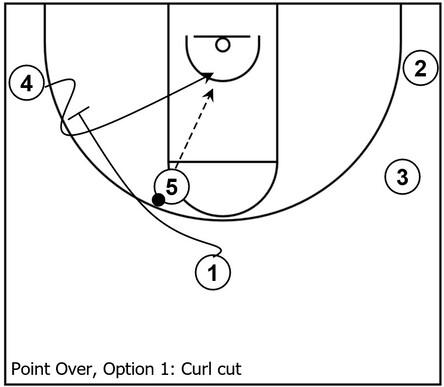
This is an example of the basic curl cut scoring option within Point Over.
To start, 1 cuts over the top of 5 to set a wide pin down screen with 4 as the recipient.
Following that, 4 uses that screen and performs a curl cut towards the basket.
Afterwards, 4 receives the ball from 5 and scores via a layup or dunk.
Option 2: Screen rejection and pop back
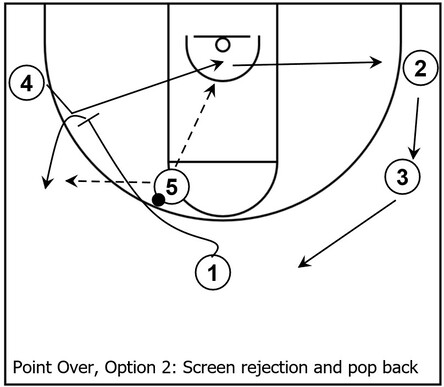
In this example, 4 rejects the screen set by 1 and backdoor cuts to the rim.
4 can receive the ball from 5 and then score around the basket.
However, if 4 is not open, then 1 could pop back towards the left side wing and receive the ball from 5 as a secondary choice.
Furthermore, 4 continues to cut through to the right side corner while 2 fills up towards the right side wing and 3 lifts up towards the right side slot area.
Option 3: Two-man pick and roll
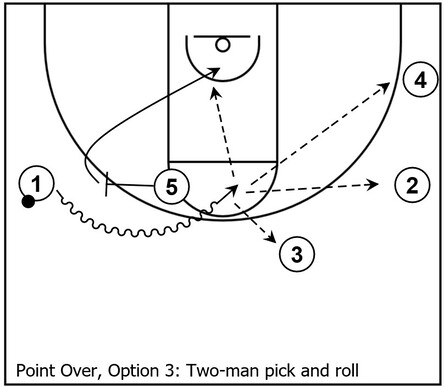
After 1 receives the ball on the previous diagram, this can lead to two-man pick and roll action between 1 and 5, particularly on the left side of the floor.
In essence, 5 can follow the previous pass into an on-ball screen and roll to the basket.
At the same time, 1 can use the pick and dribble to the high post area.
From there, 1 can take the mid-range jump shot if open or pass to one of the other players for possible scoring opportunities.
Option 4: DHO
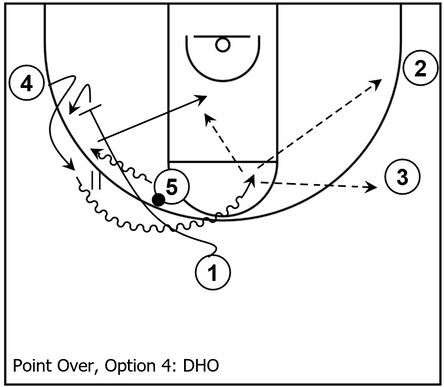
For this example, 1 cuts over the top of 5 to set a wide pin down screen.
4 uses the screen but instead of performing the curl cut, 4 cuts toward the left side wing area.
At the same time, 5 executes dribble handoff action with 4.
Moreover, 4 dribbles toward the high post area while 5 rolls to the basket and 1 fills the left side wing area.
From there, 4 can take the mid-range jump shot if that is open or pass to one of the other teammates for possible scoring opportunities.
Option 5: Point curl
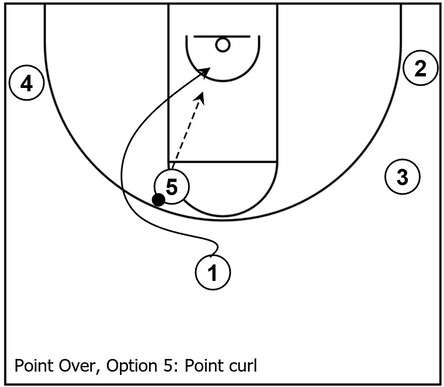
For this example, instead of cutting over the top to set a screen, 1 could simply perform a curl cut towards the basket.
After that, 1 could receive the ball from 5 and score at the rim.
This option might be viable if there is a late switch, particularly with the high post defender or if the point’s defender goes under the ball in an attempt to jam the potential wide pin down screen.
Option 6: Point handoff
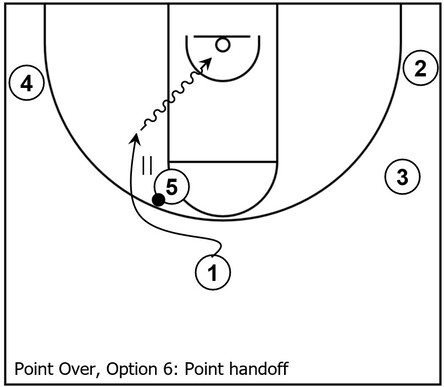
This is yet another example of a variation that could happen instead of the wide pin down action.
Essentially, after cutting over the top, 1 could simply receive the ball as a handoff from 5 and dribble towards the basket to score.
1 may also throw kick passes to the other teammates near perimeter areas depending on defensive actions.
Additional Resources for Point series
Effective Sets out of the Princeton Offense: “Point” – YouTube
Furman Paladins | Princeton Offense – Point Series – YouTube
Princeton Offense | POINT Series explained | “Away” “Over” “Under” – YouTube